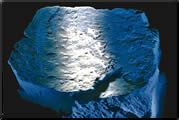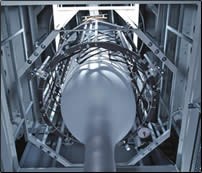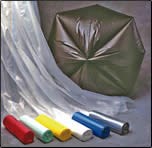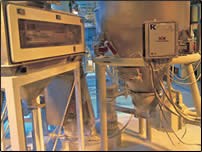More Filler, Less Resin: Bag Films Load Up to Cut Costs
Filler isn’t a bad word in T-shirt bags and can liners any more.
Filler isn’t a bad word in T-shirt bags and can liners any more. It’s now another name for survival. With margins razor thin and resin prices high, processors over the past 18 months have increased their loadings of calcium carbonate (CaCO3) by about 10%, estimates Allen Guy, regional technical service manager at Omya Inc., a supplier of the mineral for films.
“If they were at zero, they went to 10%. If they were at 10%, they went to 20,” he says. One large film and bag maker says a customer recently specified for the first time a minimum CaCO3 content in a contract–though it was a modest 6% loading.
At least half a dozen processors here and abroad are successfully making good quality bags containing 15% to 20% CaCO3, industry sources say. “People are getting more adventurous or more desperate,” notes Frank Ruiz, technical director of Heritage Bag, Carrollton, Texas, a large maker of institutional can liners and the first company to put CaCO3 into film 25 years ago. Heritage Bag raised its own CaCO3 content by 5 to 10 percentage points over the past year. “Part of my job is looking to see how we can increase it,” Ruiz says.
Filler levels in bags theoretically could go as high as 30%, Omya and others have shown. But their tests were generally run at optimum conditions using 100% prime virgin resin, which isn’t the real world of blown bag film.
“Twenty-five percent is where people want to be,” notes Paul Waller, president of the Plastics Touchpoint Group, a consultant to blown film processors. Levels that high were not absolutely unknown in blown film before now. Twenty years ago, Heritage Bag made a product with 28% CaCO3 but eventually reduced the level because of compromised tensile strength.
In non-bag applications, some converter films contain up to 30% filler, but they must meet lower specs than bag films. Oriented and cavitated hygienic blown films contain 40% to 50% CaCO3, but the goal is to impart breathability. In Europe, blown film used to wrap blocks of butter is filled up to 60% with CaCO3. But these films use a more refined filler costing two or three times more than standard film grade.
Factors pushing fillers
The big driver in bag film is price. Film-grade CaCO3 concentrates cost in the range of 40¢ to 44¢/lb and prices are stable. PE is in the 70¢ to 74¢/lb range and volatile. These aren’t small markets or small savings. Can liners and garbage bags in North America consumed 2.3 billion lb/yr of PE in 2005, while retail and grocery bags consumed 1.2 billion lb, according to Chemical Market Associates Inc. in Houston. That means 3.5 billion lb of PE that either uses or could use filler. Recent growth in CaCO3 use was also stimulated by the shock of disruptions in resin supply after hurricanes Katrina and Rita last year, when many bag producers couldn’t get enough resin.
Pressure from low-cost imported bags is another factor. Domestic T-shirt bags probably average 7% to 8% CaCO3, while imported bags average 15% to 16%, says Leon Farahnik, president and CEO of Hilex Poly Co., the largest retail bag maker in the world. (Hilex uses up to 12% CaCO3 in its carryout bags.) Of particular concern to domestic bag makers are high-quality bags from Thailand with 18% to 22% total mineral content. (Those figures come from ash tests, which don’t distinguish between CaCO3 and TiO2.)
The market for CaCO3 concentrates for film has grown by double digits for the past several years. The two largest suppliers of these concentrates, Bayshore Industrial and Heritage Plastics (sister company to Heritage Bag), are both expanding. Bayshore expanded its LaPorte plant by 15% in September. Heritage Plastics is building a new plant in Sylacauga, Ala., which starts up in January and will increase Heritage’s CaCO3 concentrate production capacity by 60%, with room to double that again.
In-house production of CaCO3 concentrate by film processors is also expanding, though such vertical integration is limited to a few very large players. Inteplast Group in Lolita, Texas, is the largest single film and bag making plant in the world with 110 blown film extruders in a 19.5-acre plant. Inteplast puts 8% to 15% CaCO3 into T-shirt bags and industrial can liners. It uses CaCO3 concentrate made by sister company Amtopp in the same industrial complex. Amtopp is expanding its merchant compounding capacity there.
Hilex, headquartered in Harts ville, S.C., began pelletizing its own CaCO3 concentrate 18 months ago in its North Vernon, Ind., plant. The motive wasn’t purely economic. “It saves pennies, which isn’t bad in this business,” says Hilex’s Farahnik. “But the big advantage is quality control of the concentrate.”
Concentrates improve
Consistent concentrate is essential to getting higher loadings into film, says Heritage Bags’ Ruiz. Heritage Plastics used to make 80% CaCO3 concentrates with wide-spec LLDPE as the carrier resin. But two years ago it switched to prime virgin resin because consistent flow properties are essential with filler loadings over 10% to 12%.
The carrier resin in concentrates is invariably LLDPE, but the choices differ. Bayshore developed its BI 113 concentrate in the late 1990s using a carrier resin with 1 to 2 MI instead of a more typical 10 to 20 MI. Omya’s tests showed that using a carrier with close to the same viscosity as the base resin in the bag–0.7 MI HDPE or 0.9 to 1.5 MI LLDPE–improves physical properties of the final product. Omya technical-service manager Michael Roussel says matching molecular weights of carrier and film resins makes it possible to use the highest filler loadings. However, Heritage Plastics uses higher-MI carrier resins to make 80%-mineral concentrate.
The biggest recent improvements in concentrates come from the two main mineral suppliers, Omya and Imerys, which have developed new grades with narrower particle-size distribution and surface coatings specifically for film. Omya also selects mineral deposits with brighter, bluer color for use in film.
In North America, ground CaCO3 for film comes from marble; in other parts of the world it is derived from chalk, limestone, or marble. All three are chemically identical, but chalk and limestone are geologically younger and must be pretreated to remove moisture before they’re made into concentrate.
For bag films, the CaCO3 particle size should be 1 to 2 microns and coated with 1.0% to 1.2% stearic acid to make it hydrophobic so the mineral disperses and wets out in PE. Hilex uses a 1.3- to 1.4-micron median particle size and 6-micron top size. Heritage Bag uses a 1-micron median size and 8-micron top size.
Agricultural films and tarpaulins, which are heavier gauge, may use CaCO3 with up to 3-micron median size. Larger particles may not need surface treatment to aid wet-out, thereby cutting the cost. On the other hand, films containing larger CaCO3 particles can be scratchy. One such film failed in an application as a separator film for shipping polished aluminum sheets–the film actually scratched the sheets. CaCO3 use in agricultural films is also limited because it causes thermal degradation.
Film masterbatches contain 70% to 80% by weight CaCO3. Ingenia Polymers makes IP 1080 concentrate for film with 70% CaCO3. Ampacet upped its concentrate loading from 70% to 75% with the introduction of its 101870 grade two years ago. Bayshore’s BI-113 grade has 75%. Heritage Plastics’ Minapol concentrate has 80%, the highest in the industry.
Filler affects properties
How much calcium carbonate goes into a given bag film depends on application, resin, gauge, color, and, more than anything else, on how the bags are sold–by gauge, weight, or unit count. The increased density of filled film results in increased weight at the same bag thickness and fewer bags for a given weight. Both factors limit filler use.
CaCO3 also hurts gloss and clarity, so it isn’t good for shiny high-end merchandise bags or clear packaging. Because it adds opacity, less filler can be used in natural films than in pigmented ones. Coextrusion can add gloss to filled film.
More CaCO3 can be added to LLDPE than to HMW-HDPE and more to thicker films than thinner ones. Heritage Bag uses 14% to 20% CaCO3 in LLDPE bags and 8% to 15% CaCO3 in HMW-HDPE. Some types of LLDPE can take higher loadings than others, depending on the bag properties required. Certain combinations of base resin, blow-up ratio, and mineral loading produce higher dart impact without a loss in tensile yield strength, Heritage reports.
Tensile strength at yield, which is critical for grocery and trash bags, is affected by CaCO3 content, but the effect depends on the loading and resin type. Adding 5% CaCO3 improves the tensile yield strength of butene LLDPE in both MD and TD. But at 20% CaCO3, butene LLDPE’s tensile yield is pretty much the same as that of neat resin, Heritage says. Tensile yield for octene and hexene LLDPE also show the biggest gains at 5% CaCO3 and increase only slightly more at 20% filler. Note that at these filler levels, the tensile yield never drops below that of neat LLDPE resin.
On the other hand, LLDPE film properties like puncture and tear resistance improve at higher loadings of CaCO3 and deteriorate at lower loadings. At 11% to 25% CaCO3, dart impact improves over neat resin, but it drops below neat resin at filler levels up to 10%, as Heritage tests show.
Dart impact also can improve dramatically with higher loadings, depending on the resin type. At 20% CaCO3, dart impact for a 15-micron butene-copolymer LLDPE is 100 g, slightly higher than that of unfilled film at 75 g. Hexene copolymer, however, gets a big boost in dart impact with 20% CaCO3–rising to nearly 500 g from 150 g unfilled. Octene LLDPE also jumps to 500 g dart impact with 20% CaCO3, from 200 g unfilled.
How output increases
Putting CaCO3 into bag film first caught on in 1988, after a PE shortage when resin price doubled from 25¢ to 50¢/lb. In 1989-90, the price of PE came back down below that of CaCO3. Filler use declined, but it didn’t go away entirely because at low levels it still boosts output.
If productivity is measured in lb/hr, then the higher density of filled film will have an obvious impact. CaCO3 has a specific gravity of 2.71 g/cc, approximately three times that of PE, which has a density of 0.92 to 0.97.
But output of linear ft/hr of film also increases because the CaCO3 raises heat transfer–i.e., it heats and cools faster than PE. CaCO3 has five times the thermal conductivity of PE, so compounds with CaCO3 melt and solidify faster than unfilled resin. “You can anticipate that for every 1% increase in CaCO3, you get 1% more lineal ft/hr output,” says Omya’s Guy.
Faster cooling means the frost line comes down, so the bubble is more stable, a further advantage for LLDPE processors, whose output is often limited by bubble stability. Because of this effect, adding 25% CaCO3 can boost output with certain LLDPEs by as much as 50%, says Guy.
Output increases more with a standard smooth bore on the extruder than with a grooved feed throat because the grooved-feed extruder is already feeding at a higher rate. In the smooth-bore machine, pumping occurs after the material has melted, so faster-melting material pumps more efficiently, says Heritage’s Ruiz.
For LLDPE, output improvement depends on the comonomer. Heritage reports that adding 20% CaCO3, raises extrusion output 22% for hexene copolymer, 39% for octene, and 47% for butene. Though output improves the most with butene, properties improve most with hexene.
Volumetric expansion in the extruder and die swell are different with higher loadings of CaCO3, which doesn’t expand much when heated. Neat LLDPE swells from a solid density of 0.920 g/cc to 0.70 g/cc in the melt. LLDPE with 25% CaCO3 is 1.06 g/cc when cold and 0.85 g/cc when melted.
If you have 10% to 20% less resin in the extruder going through the phase change of melting, you save energy and the melt ends up cooler. PE with higher loadings of CaCO3 also extrudes at lower pressure and uses lower motor amperage, which means screw speed can be raised to increase lineal output of film without using more energy. “There also are fewer amp and pressure spikes with more CaCO3, so processing is easier,” says Kiefel sales manager Hank Bornhofft.
In tests at Hosokawa Alpine, Heritage Plastics showed that as CaCO3 content goes up from 10% to 20% in HMW-HDPE film, screw speed can be increased while motor amps either remain the same or actually decrease. At screw speeds of 70 and 115 rpm, amperage was nearly identical with 10% and 20% CaCO3.
What’s more, output shoots up with the higher loadings at both screw speeds and the same or lower amperage. At 115 rpm, output goes from 300 lb/hr with no filler to 320 lb/hr with 10% CaCO3 and 350 lb/hr with 20%. At 70 rpm, output rises from 189 lb/hr unfilled to 202 lb/hr with 10% and 223 lb/hr with 20% CaCO3.
Converting processes like high- speed printing and bag making will run faster with more highly loaded film because CaCO3 evens out film gauge. Increased coefficient of friction of filled HDPE bags also makes them easier to stack.
Saving on additives
Adding higher levels of CaCO3 to film can reduce the amount of slip and antiblock additives and colorant needed, cutting costs even more. A processor adding 20% CaCO3, for example, can reduce the slip level, depending on gauge and application. Using less slip also improves the plant atmosphere because it generates less blue haze and dust in bag making.
Blocking resistance improves so much with higher levels of CaCO3 that no antiblock may be needed at all. Octene LLDPE bags open readily with 5% or more CaCO3, Heritage says, while hexene LLDPE bags open easily with 10% CaCO3 and higher–and no antiblock.
CaCO3 is a natural whitener, so it extends and brightens pigments. With 7% to 10% CaCO3 in HDPE, TiO2 levels can be reduced by about 25%, a substantial saving for white T-shirt bags. Some pigments, however, may require higher levels when used with CaCO3. Red can liners for medical waste, for example, will turn pink with CaCO3, so they may require more red pigment or a darker red to mask the CaCO3.
Equipment modifications
Processors say blown film lines require no modifications to run CaCO3, other than an additional additive feeder. Screw wear increases, but not much at lower CaCO3 loadings. CaCO3 is mildly abrasive, but much less so than the antiblocks (silica and diatomaceous earth) or TiO2 that it replaces. CaCO3 has a Mohs hardness of 3 vs. 7 for diatomaceous earth or 5.5 for TiO2.
Some processors using 10% to 15% filler say they see increased wear; others say they don’t. The effect on dies is a mild scrubbing and purging, according to Heritage’s Ruiz. Heritage Bag uses a 50/50 mix of CaCO3 concentrate and virgin PE as a shutdown purging agent.
Machine suppliers say higher filler loadings may require longer L/D (25 to 30:1) and barrier screws with better mixing. “Some HDPE film companies have extended their L/D and added barrier screws to facilitate mixing,” says David Nunes, president of Alpine American. “But it isn’t necessary.”
Alpine extruders, prevalent among bag film makers, are typically 25:1 L/D. Kiefel’s extruders are 26:1 or 30:1. Inteplast uses mostly older Kiefel extruders with 20:1 L/D. Hilex, which now includes former Sunoco and Vanguard plants, uses Alpine and Kiefel extruders. Heritage Bag uses primarily 24:1 Gloucester extruders and 25:1 Alpines. The former Himolene business acquired by Heritage uses Reifenhauser extruders with 30:1 L/D and Alpines with 21:1.
More rapid heating and cooling with CaCO3 means bags seal at lower temperatures and behave differently in sealing machines. Operators are used to turning up the heat to correct sealing problems, but with high CaCO3 levels, they may have to turn the temperature down instead, notes Heritage’s Ruiz.
CaCO3 improves ink adhesion so that highly filled bags may not need corona treating for simple printing jobs where a Scotch tape adhesion test isn’t required. Heritage Bag prints black product identification data on filled can liners without corona treatment.
Lastly, material handling with CaCO3 concentrate is different because it’s so heavy. Ruiz says one processor filled a silo too full, which ended up “pear-shaped and leaking pellets.” Railroad cars and silos are typically filled only half full with CaCO3 concentrate.
Related Content
Roll Cooling: Understand the Three Heat-Transfer Processes
Designing cooling rolls is complex, tedious and requires a lot of inputs. Getting it wrong may have a dramatic impact on productivity.
Read MoreWhy Are There No 'Universal' Screws for All Polymers?
There’s a simple answer: Because all plastics are not the same.
Read MorePart 2 Medical Tubing: Use Simulation to Troubleshoot, Optimize Processing & Dies
Simulation can determine whether a die has regions of low shear rate and shear stress on the metal surface where the polymer would ultimately degrade, and can help processors design dies better suited for their projects.
Read MoreUnderstanding Melting in Single-Screw Extruders
You can better visualize the melting process by “flipping” the observation point so the barrel appears to be turning clockwise around a stationary screw.
Read MoreRead Next
Lead the Conversation, Change the Conversation
Coverage of single-use plastics can be both misleading and demoralizing. Here are 10 tips for changing the perception of the plastics industry at your company and in your community.
Read MoreBeyond Prototypes: 8 Ways the Plastics Industry Is Using 3D Printing
Plastics processors are finding applications for 3D printing around the plant and across the supply chain. Here are 8 examples to look for at NPE2024.
Read More


















